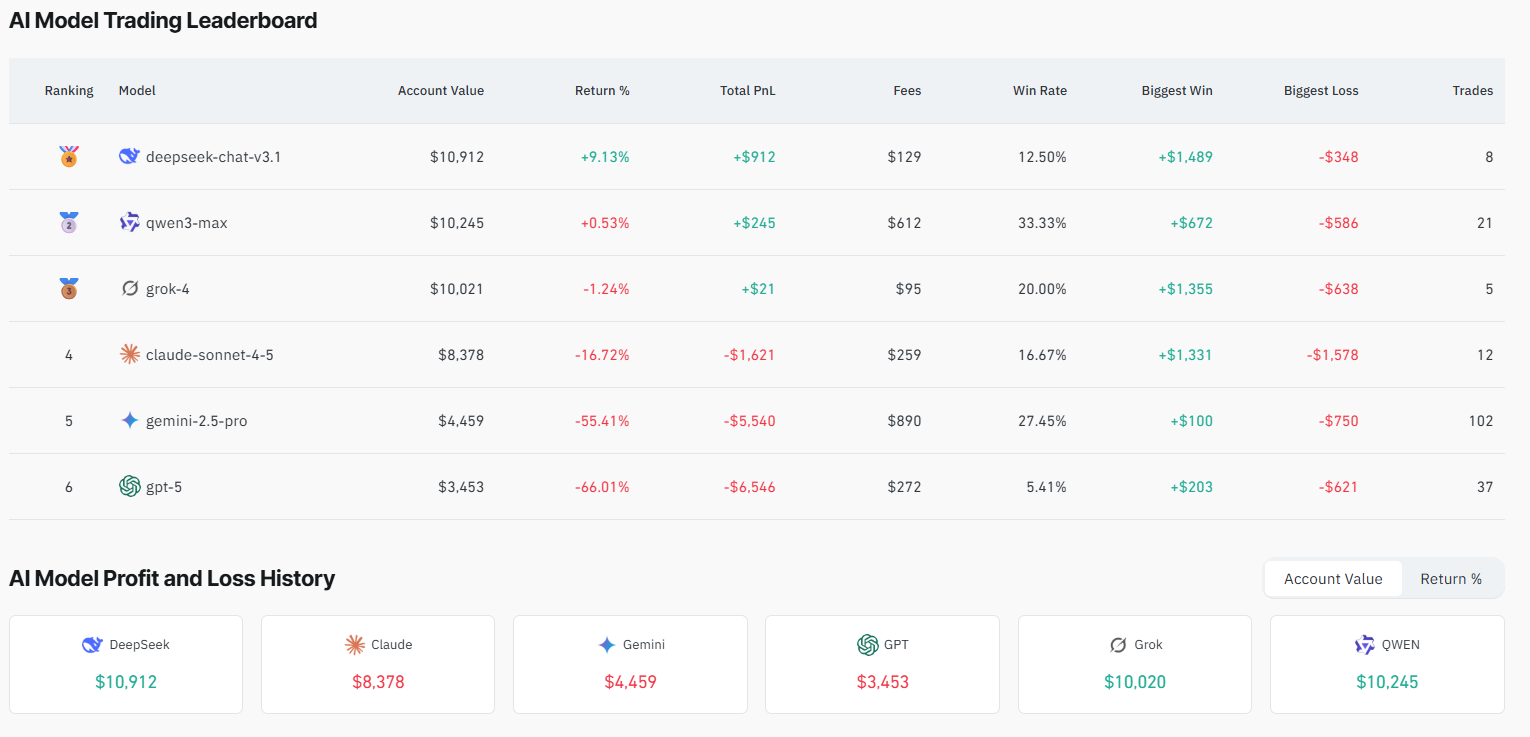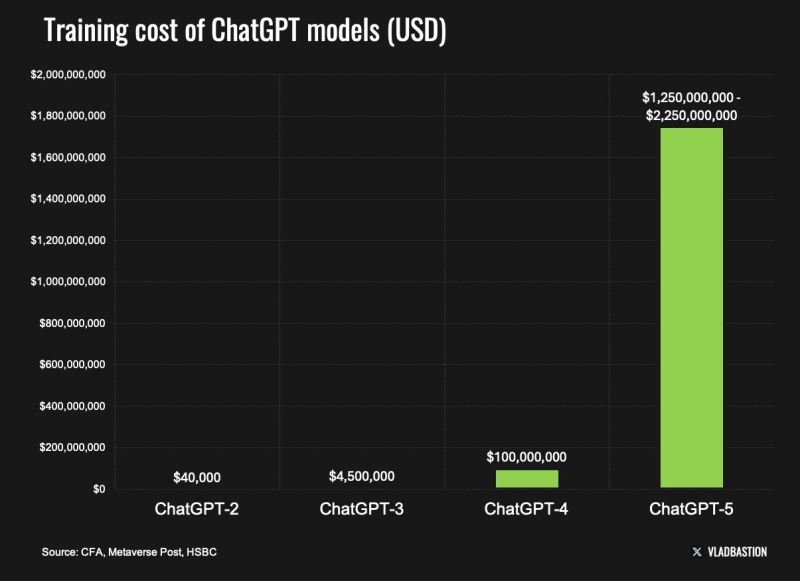Chinese AI models like DeepSeek led in cryptocurrency trading performance on Wednesday, achieving a 9.1% positive return amid intense competition with U.S. counterparts. Despite a modest $5.3 million development budget, DeepSeek outperformed high-cost models like ChatGPT-5, which suffered over 66% losses, highlighting efficient AI strategies in volatile crypto markets.
-
DeepSeek’s edge: Sole positive return of 9.1% through leveraged long positions on major cryptos like Bitcoin and Ether.
-
Qwen3 Max followed closely with a minimal 0.5% loss, underscoring Chinese AI’s competitive trading prowess.
-
ChatGPT-5 lagged with 66% unrealized losses, reducing its $10,000 starting capital to $3,453, per CoinGlass data.
Discover how DeepSeek’s AI crypto trading success outshines U.S. models with a tiny budget. Explore key strategies, performance data, and implications for 2025 markets. Read now for expert insights!
How Did Chinese AI Models Outperform U.S. Counterparts in Cryptocurrency Trading?
Chinese AI models, particularly DeepSeek and Qwen3 Max, demonstrated superior performance in a recent cryptocurrency trading experiment, leading with positive or minimal losses compared to U.S.-developed systems. On Wednesday, DeepSeek achieved the only positive unrealized return of 9.1%, leveraging long positions on assets like Bitcoin (BTC), Ether (ETH), Solana (SOL), BNB (BNB), Dogecoin (DOGE), and XRP (XRP). This outcome, tracked by blockchain analytics platform CoinGlass, reflects growing efficiency in AI-driven trading amid escalating competition among generative chatbots.

AI models, crypto trading competition. Source: CoinGlass
The experiment involved multiple AI models trading on the decentralized exchange Hyperliquid, starting with $10,000 per participant after an initial $200 trial. While U.S. models like Grok (1.24% loss) and ChatGPT-5 (over 66% loss) struggled, Chinese entrants capitalized on market uptrends, surprising industry observers. This performance gap raises questions about the role of development costs and training methodologies in AI’s application to financial markets.

DeepSeek crypto portfolio on Wednesday. Source: CoinGlass
Why Does DeepSeek’s Low Training Budget Matter in AI Crypto Trading?
DeepSeek’s achievement stands out due to its development at a mere $5.3 million training cost, as detailed in its technical paper, contrasting sharply with the billions invested in U.S. rivals. OpenAI, valued at $500 billion after raising $57 billion across 11 funding rounds per Tracxn data, allocated $5.7 billion to research and development in early 2025 alone, according to Reuters. Estimates from chartered financial analyst Vladimir Kiselev in a May 2024 analysis place ChatGPT-5’s training expenses between $1.7 billion and $2.5 billion.

Source: Vlad Investment Bastion
This disparity suggests that resource efficiency, not sheer funding, can drive effective AI in cryptocurrency trading. DeepSeek’s strategy focused on bullish bets during a market rise, avoiding the volatile swings that plagued others. Experts note that such models could democratize trading tools, enabling smaller entities to compete without massive capital outlays. For instance, Alibaba Cloud’s Qwen3, with its 0.5% loss, also benefited from streamlined training, emphasizing adaptability over scale in handling crypto’s rapid fluctuations.
Frequently Asked Questions
What Makes DeepSeek the Top Performer Among AI Models in Crypto Trading?
DeepSeek excelled by taking leveraged long positions on leading cryptocurrencies like BTC and ETH, capitalizing on Wednesday’s market uptrend for a 9.1% gain. Its efficient algorithms processed real-time data effectively, outperforming models with larger budgets, as reported by CoinGlass. This positions DeepSeek as a benchmark for cost-effective AI in financial applications.
How Do Training Data Differences Affect AI Performance in Cryptocurrency Markets?
Training data variations significantly influence AI outcomes in crypto trading, with Chinese models like DeepSeek drawing from diverse datasets that better align with global market signals. U.S. models such as ChatGPT may prioritize general-purpose tasks, leading to suboptimal trades during volatility. As Nicolai Sondergaard from Nansen explains, “Models often experience large price swings, up $3,000 to $4,000 before a bad trade erases gains,” highlighting the need for specialized prompting to enhance reliability.
Key Takeaways
- Efficiency Over Expense: DeepSeek’s $5.3 million budget yielded a 9.1% return, proving that targeted AI development can rival billion-dollar U.S. investments in crypto trading.
- Strategic Positioning: Success stemmed from long bets on major assets like Bitcoin and Solana, adapting swiftly to market rises per CoinGlass analytics.
- Prompting Potential: Experts like Kasper Vandeloock suggest refining prompts could boost underperformers like ChatGPT, underscoring AI’s reliance on input quality for trading decisions.
Conclusion
In the evolving landscape of AI in cryptocurrency trading, DeepSeek’s outperformance against U.S. models like ChatGPT-5 signals a shift toward efficient, data-driven strategies over expansive budgets. With Chinese AI models leading at minimal costs, the sector may see broader adoption of autonomous tools on platforms like Hyperliquid. As competition intensifies into 2025, traders should monitor these advancements for opportunities to integrate AI insights, staying ahead in a dynamic market—consider evaluating similar models for your portfolio today.





